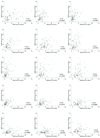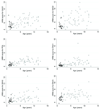Use of a high resolution melting assay to analyze HIV diversity in HIV-infected Ugandan children
- PMID: 22785048
- PMCID: PMC3473149
- DOI: 10.1097/INF.0b013e3182678c3f
Use of a high resolution melting assay to analyze HIV diversity in HIV-infected Ugandan children
Abstract
Background: We used a novel high resolution melting (HRM) diversity assay to analyze HIV diversity in Ugandan children (age 0.6-12.4 years) who were enrolled in an observational study of antiretroviral treatment (ART). Children were maintained on ART if they were clinically and immunologically stable.
Methods: HIV diversity was measured before ART (baseline) in 76 children and after 48 or 96 weeks of ART in 14 children who were not virally suppressed. HIV diversity (expressed as HRM scores) was measured in 6 regions of the HIV genome (2 in gag, 1 in pol, 3 in env).
Results: Higher baseline HRM scores were significantly associated with older age (≥2 years, P ≤ 0.001 for all 6 regions). HRM scores from different regions were weakly correlated. Higher baseline HRM scores in 3 regions (1 in gag, 2 in env) were associated with ART failure. HIV diversity was lower in 4 regions (2 in gag, 1 in pol, 1 in env) after 48-96 weeks of nonsuppressive ART compared with baseline.
Conclusions: Higher levels of HIV diversity were observed in older children before ART, and higher levels of diversity in some regions of the HIV genome were associated with ART failure. Prolonged exposure to nonsuppressive ART was associated with a significant decrease in viral diversity in selected regions of the HIV genome.
Conflict of interest statement
None of the authors have a commercial or other association that might pose a conflict of interest.
Figures


References
-
- Tebit DM, Nankya I, Arts EJ, et al. HIV diversity, recombination and disease progression: how does fitness "fit" into the puzzle? AIDS Rev. 2007;9:75–87. - PubMed
-
- Leal E, Janini M, Diaz RS. Selective pressures of human immunodeficiency virus type 1 (HIV-1) during pediatric infection. Infect Genet Evol. 2007;7:694–707. - PubMed
Publication types
MeSH terms
Substances
Grants and funding
LinkOut - more resources
Full Text Sources
Other Literature Sources
Medical

